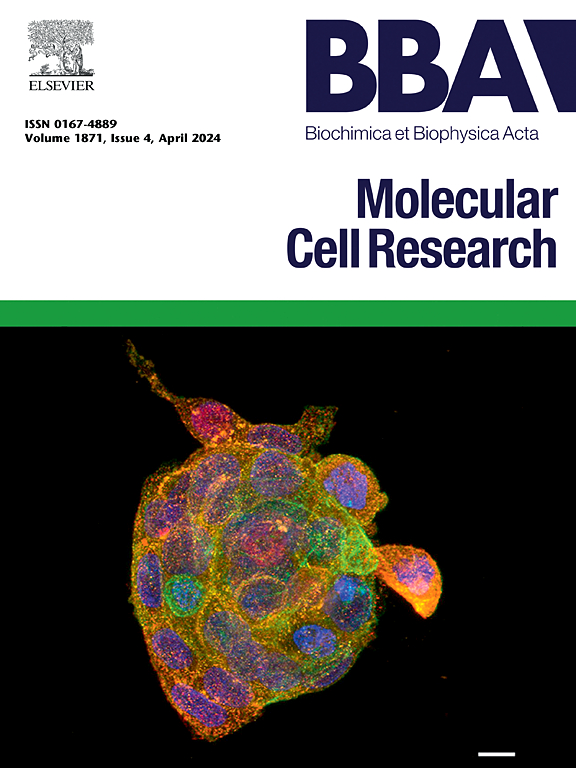Improving mitochondria-associated endoplasmic reticulum membranes integrity as converging therapeutic strategy for rare neurodegenerative diseases and cancer
IF 3.7
2区 生物学
Q1 BIOCHEMISTRY & MOLECULAR BIOLOGY
Biochimica et biophysica acta. Molecular cell research
Pub Date : 2025-04-09
DOI:10.1016/j.bbamcr.2025.119954
引用次数: 0
Abstract
Membrane contact sites harbor a distinct set of proteins with varying biological functions, thereby emerging as hubs for localized signaling nanodomains underlying adequate cell function. Here, we will focus on mitochondria-associated endoplasmic reticulum membranes (MAMs), which serve as hotspots for Ca2+ signaling, redox regulation, lipid exchange, mitochondrial quality and unfolded protein response pathway. A network of MAM-resident proteins contributes to the structural integrity and adequate function of MAMs. Beyond endoplasmic reticulum (ER)-mitochondrial tethering proteins, MAMs contain several multi-protein complexes that mediate the transfer of or are influenced by Ca2+, reactive oxygen species and lipids. Particularly, IP3 receptors, intracellular Ca2+-release channels, and Sigma-1 receptors (S1Rs), ligand-operated chaperones, serve as important platforms that recruit different accessory proteins and intersect with these local signaling processes. Furthermore, many of these proteins are directly implicated in pathophysiological conditions, where their dysregulation or mutation is not only causing diseases such as cancer and neurodegeneration, but also rare genetic diseases, for example familial Parkinson's disease (PINK1, Parkin, DJ-1), familial Amyotrophic lateral sclerosis (TDP43), Wolfram syndrome1/2 (WFS1 and CISD2), Harel-Yoon syndrome (ATAD3A). In this review, we will discuss the current state-of-the-art regarding the molecular components, protein platforms and signaling networks underlying MAM integrity and function in cell function and how their dysregulation impacts MAMs, thereby driving pathogenesis and/or impacting disease burden. We will highlight how these insights can generate novel, potentially therapeutically relevant, strategies to tackle disease outcomes by improving the integrity of MAMs and the signaling processes occurring at these membrane contact sites.
改善线粒体相关内质网膜完整性作为罕见神经退行性疾病和癌症的会聚治疗策略
膜接触位点包含一组具有不同生物功能的独特蛋白质,因此成为定位信号纳米结构域的枢纽,从而使细胞功能充分发挥。在这里,我们将重点关注线粒体相关内质网膜(MAMs),它是Ca2+信号传导、氧化还原调节、脂质交换、线粒体质量和未折叠蛋白反应途径的热点。mam驻留蛋白的网络有助于mam的结构完整性和适当的功能。除了内质网(ER)-线粒体栓系蛋白外,MAMs还含有几种多蛋白复合物,可介导Ca2+、活性氧和脂质的转移或受其影响。特别是,IP3受体,细胞内Ca2+释放通道和Sigma-1受体(S1Rs),配体操作的伴侣,作为招募不同辅助蛋白和与这些局部信号传导过程相交的重要平台。此外,这些蛋白中的许多与病理生理条件直接相关,其中它们的失调或突变不仅导致癌症和神经退行性疾病,而且还导致罕见的遗传疾病,例如家族性帕金森病(PINK1, Parkin, DJ-1),家族性肌萎缩侧索硬化症(TDP43), Wolfram综合征1/2 (WFS1和CISD2), harell - yoon综合征(ATAD3A)。在这篇综述中,我们将讨论目前关于MAM完整性和细胞功能的分子成分、蛋白质平台和信号网络的最新进展,以及它们的失调如何影响MAM,从而推动发病机制和/或影响疾病负担。我们将强调这些见解如何通过提高MAMs的完整性和发生在这些膜接触部位的信号传导过程来产生新的、潜在的治疗相关策略,以解决疾病结果。
本文章由计算机程序翻译,如有差异,请以英文原文为准。
求助全文
约1分钟内获得全文
求助全文
来源期刊
CiteScore
10.00
自引率
2.00%
发文量
151
审稿时长
44 days
期刊介绍:
BBA Molecular Cell Research focuses on understanding the mechanisms of cellular processes at the molecular level. These include aspects of cellular signaling, signal transduction, cell cycle, apoptosis, intracellular trafficking, secretory and endocytic pathways, biogenesis of cell organelles, cytoskeletal structures, cellular interactions, cell/tissue differentiation and cellular enzymology. Also included are studies at the interface between Cell Biology and Biophysics which apply for example novel imaging methods for characterizing cellular processes.

 求助内容:
求助内容: 应助结果提醒方式:
应助结果提醒方式:


